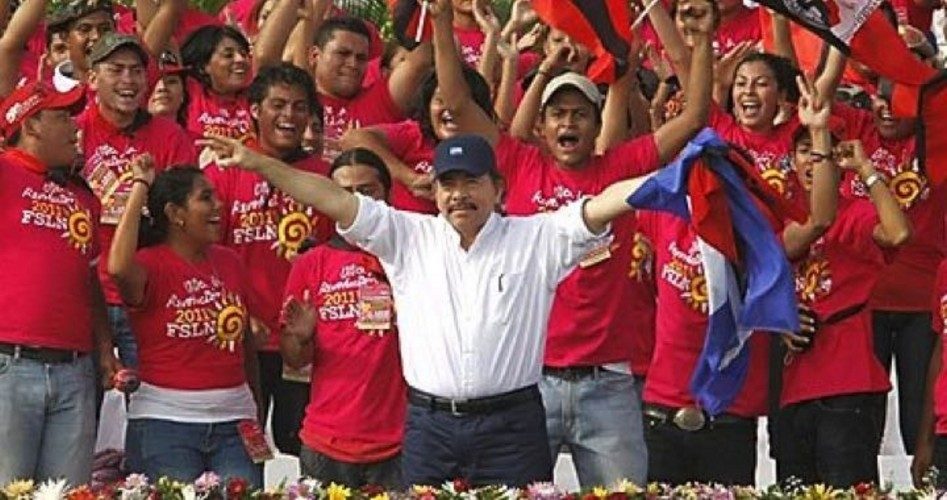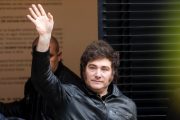
Nicaragua’s totalitarian-minded leftist government, led by Sandinista Daniel Ortega, has responded to a growing uprising against the regime by murdering journalists, brutalizing and slaughtering protesters, and terrorizing the public. According to news reports and human-rights activists, the “former” Marxist mass-murderer is also unleashing savage gangs to dispense violence on his behalf and crush the opposition. Dozens have died already. And unless Ortega decides to relinquish power peacefully, analysts expect the body count to keep rising. The chaos has regional implications, too.
Officially, the protests began in April as a response to relatively minor changes to the regime’s “social security” scheme. Under the plan, benefits would be cut slightly, and taxes would be raised a bit. Officials said the changes were necessary to keep the system afloat. At first, people went into the streets to protest peacefully. But when the regime responded with brute force, those demonstrations quickly morphed into a veritable nationwide uprising against the longtime ruler who has been in power for more than two decades total, with a stint out of power in the middle. At least until the uprising, Ortega’s plan was to eventually have his family take the reins.
Since the protests began, the regime has backed down on the changes to the pension system, but hundreds of thousands have now poured out into the streets to join the movement. One of the catalysts was the murder of journalist Angel Gahona while he was live-streaming a report about the protests over social media. The use of live ammunition against protesters, with echoes of the ongoing horror show unleashed by close Sandinista ally and socialist strongman Nicolas Maduro in Venezuela, fueled the anti-regime fervor. And what began as an outcry against now-reversed changes to social security has become a national outcry seeking massive societal and political changes, including the departure of the Ortega-Sandinista regime run by the National Liberation Sandinista Front (FSLN).
According to multiple news reports and investigations by human-rights observers, the regime has even instituted a “shoot to kill” policy to crush the protests. Nearly 100 murders of protesters have already been documented, with more yet to be tabulated. Almost 1,000 more have been wounded in the attacks amid mass arrests. Sources in Nicaragua confirmed to The New American that FSLN gangs have been shooting anti-Ortega protesters with impunity — and that they seem to be protected by the police, who do little to nothing to stop the slaughter and violence. In videos taken with cellphones, pro-regime thugs can also be seen brutally beating protesters, too. Police stand by and do nothing, or worse, partake in the attacks.
Even fellow leftists have turned against the regime in Managua. “The Nicaraguan authorities have turned on their own people in a vicious, sustained and frequently lethal assault on their rights to life, freedom of expression and peaceful assembly,” explained Erika Guevara-Rosas, the Americas director for the notoriously left-wing human-rights group Amnesty International. “The government of President Ortega has then shamelessly tried to cover up these atrocities, violating the victims’ rights to truth, justice and reparation.”
In a report released on May 29 entitled “Shoot to kill: Nicaragua’s strategy to repress protest,” the human-rights network documented some of the abuses and crimes perpetrated by the regime, ranging from extrajudicial killings to violent attacks on dissidents. The 36-page report concludes that people’s legitimate right to protest is being unlawfully suppressed using criminal tactics. The organization also concluded that the “strategy adopted by the Nicaraguan authorities, which has resulted in, among other things, an alarming number of fatalities and serious injuries, was intended to punish dissenting voices, discourage further public criticism and cover up human rights violations and crimes,” the report said, blasting the dictator and his wife, who serves as vice president, for denying the crimes and vilifying the protesters.
The group called for an immediate end to the brutality and for perpetrators to be held accountable. “The state must immediately stop repressing the people who protest, particularly young students, and respect their right to criticize public policies,” Amnesty’s Guevara-Rosas said. “Instead of criminalizing them, the government of President Ortega must allow an international commission to be established to carry out a prompt, impartial and effective investigation, and, where appropriate, bring charges against all those suspected of committing or ordering extrajudicial executions or the excessive use of force and other serious human rights violations and crimes under international law.”
In a throwback to the early days of the Sandinista takeover of Nicaragua, even Catholic institutions and clerics have been attacked by the regime and its allies. The Catholic University of Central America, for example, which is perceived by the tyrant as a hub of student activism, was targeted by the regime with violence. Among other instances of terror, a group of masked men in vans showed up and shot mortars at campus guards. The rector of the university, Fr. Jose Alberto Idiaquez, condemned the “cowardly” attack by would-be murderers “armed with impunity guaranteed to them by the current government.”
Indeed, the brutality unleashed by authorities has been so savage that it led at least one senior Catholic official to suggest that the viciousness of the regime was out of this world — even demonically inspired. “What is happening in Nicaragua are not just social and political phenomena,” said Catholic leader Silvio Fonseca, who serves as the pastoral vicar of Family, Life, and Childhood at the Archdiocese of Managua. “Instead, there are satanic forces that are taking this country to what we are seeing — these massacres, the violation of human rights.”
Still, the Catholic Church is attempting to mediate some sort of solution to the crisis. Rolando Alvarez, bishop of Matagalpa and a member of Nicaragua’s Episcopal Conference, outlined what is hoped for as negotiations proceed. “We hope there would be a series of electoral reforms, structural changes to the electoral authority — free, just and transparent elections, international observation without conditions,” he said. “Effectively, the democratization of the country.” More than a few leaders of the uprising, though, say that until Ortega and his family and his cronies are out of power, there will be no end to the unrest.
Despite the loss of domestic allies amid the uprising at home, the regime has powerful friends outside the country. In fact, the Sandinistas of Nicaragua were among the founders of the communist Foro de Sao Paulo, or Sao Paulo Forum in English, a totalitarian alliance of communist and socialist parties and movements that at one point controlled the overwhelming majority of the region’s governments. Other founders of the network include mass-murdering Communist Party of Cuba dictator Fidel Castro, former Brazilian President Luis Inacio Lula da Silva of the Marxist-Leninist “Workers’ Party,” and the Marxist narco-terror group FARC in Colombia. Their goal, according to their own documents, is to spread communism across Latin America. The U.S. government knows all about it.
But the national movement to remove the far-left regime in Nicaragua comes as Latin America’s broader communist and socialist machine — after destroying multiple countries such as Venezuela — is increasingly on the run. In fact, many of the leading players are now out of power, and in some cases in jail. For instance, former Brazilian President Lula is now in prison for corruption. His handpicked successor, “ex”-communist terrorist Dilma Rousseff, was impeached. But in other nations, thanks in large part to the machinations of the Obama administration and the globalist-minded Council on Foreign Relations, FSP members are doing better than ever before, with Colombia and El Salvador being prime examples.
Before the latest wave of violence, the Sandinista regime in Nicaragua, like its FSP allies across the hemisphere, already had a long and brutal history of oppression, mass murder, and tyranny. With help from the murderous regimes enslaving the Soviet Union, Cuba, and other nations — combined with the betrayal of the existing government at that time, a U.S. ally, by globalists in Washington — the “revolutionaries” butchered their way to power. Once there, they continued to brutalize and slaughter people, in addition to stealing property at will and driving the economy into the ground.
Among the many crimes perpetrated by the Sandinista regime was the mass slaughter of peasants, indigenous people, and others. Jews were targeted too, as were many Christians. Indeed, refugees fleeing Ortega’s savagery in the mid-1980s reported massacres of unarmed civilians who were merely trying to escape into Costa Rica. Torture and killings of dissidents, journalists, businessmen, native peoples, Jews, and others was widespread. Estimates provided by defectors from the Sandinistas suggest that at least 5,000 people were slaughtered just in the first few months of the Sandinistas’ reign of terror.
Amid the latest crisis, interventionists in the United States are already calling on the U.S. government to intervene. “It’s up to the United States and other regional democracies [sic] to hold Ortega to account and to support the Nicaraguan people in their effort to hasten a return to democratic order in Nicaragua,” pontificated Otto Reich, a former U.S. ambassador to Venezuela and assistant secretary of state for Western Hemisphere affairs. “We are seeing what the hemisphere’s failure to confront oppressors has brought in Venezuela. Let’s not consign Nicaraguans to the same fate.” Unfortunately, though, U.S. government intervention in Latin America, aside from being unconstitutional and unwise, has tended to help totalitarian and murderous leftist forces — including being responsible for putting Castro in power.
Ironically, after putting Castro in power, the U.S. government worked to help bring communists to power in Nicaragua, too, according to the U.S. ambassador to Cuba, during the communist revolution there. “Castro could not have seized power in Cuba without the aid of the United States,” wrote former U.S. Ambassador Earl Smith, who exposed the globalist operation to help Castro enslave Cuba, in 1979. “The State Department undermined the Somoza Government by blocking all economic and military supplies while winking at clandestine smuggling of arms to the Sandinista guerrillas. Upon instructions from the State Department, William D. Bowdler, longtime Foreign Service officer, played a prominent role in forcing Somoza to leave the country. If we continue to give financial aid, very likely the money will be used to pay for the troops who have been trained in Angola, Cuba and Panama…. Nicaragua is Cuba all over again.”
Members of the conservative John Birch Society living in Nicaragua, one of whom studies law at the Polytechnic University of Nicaragua (UPOLI) that has been a point of resistance against the Ortega regime, have been sending periodic updates on the situation to The New American magazine. Among other concerns, they have warned that the situation is deteriorating quickly, and that Ortega and his minions show no signs of being ready to surrender control.
If the Trump administration wants to help without meddling in the affairs of other nations, ending all U.S. funding for subversive movements and schemes in Latin America would be an excellent place to start. Cleaning out the U.S. State Department and expunging all members of the CFR would be a major step forward, too. In the meantime, though, analysts expect the bloodshed in Nicaragua to continue as the well-connected tyrant desperately clings to power.
Photo of Daniel Ortega (in white): Fundscion Ong DE Nicaragua
Alex Newman, a foreign correspondent for The New American, is normally based in Europe but grew up in Latin America. Follow him on Twitter @ALEXNEWMAN_JOU or on Facebook. He can be reached at [email protected].
Related articles:
Resurgent Communism in Latin America
U.S. Taxpayers Fund Takeover of Colombia by Marxist Terrorists
Communist Mass-murderer Wins Suspicious El Salvador Election
Globalists and Gangs Back Marxist Mass-murderer in El Salvador
Exposure of Radical CFR Latin America Boss Offers Broad Insight
In Latin America, Russia and China Push New World Order
Council On Foreign Relations Exposed
Uprising Against Autocrats Sweeps Latin America
Olavo de Carvalho on Communism in Latin America
U.S. Ambassador Outs Powerful Totalitarian Cabal in Latin America



